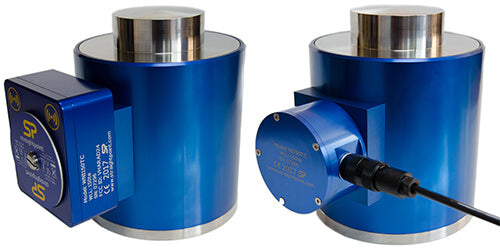
Compression Type Load Cells: Wireless vs. Wired
How to Choose the Best Compression Load Cell for your Application
Compression type load cells (commonly referred to as canister load cells or load cell pancakes) are necessary tools for compression force testing, structural weighing, and the confirmation of mass and center of gravity.
Essentially, a compression load cell is a block that's designed to sit under a load at a single point in order to measure compression. While tension load cells measure the pulling force, compression load cells are more low-profile load cells that measure pushing force along a single axis.
Compression type load cells are used in many important industries including mining, energy, defense, heavy rigging, shipping, and general transportation sectors.
However, with the advancement of wireless load cell technology, professional operators now have more compression load cell choices than ever before. Should you go with the old-school wired option or upgrade to a more modern wireless model? Read on to learn the advantages of each compression type load cell, plus our expert recommendation.
Wireless Compression Load Cells
Wireless compression load cells use an internal antenna to electronically transmit load cell readings and alerts to a wireless handheld readout device, computer, or smartphone.
Advantages
Where do we begin? By eliminating the need for external cables, wireless compression load cells offer a number of major advantages. First, you're able to be more mobile on the job site and aren't limited to a fixed location. As long as you're within signal range, you can be anywhere you need to be. Next, you don't have to deal with the complexity of setting up cables and running them around obstructions. This saves time and allows the load cells to be used in more diverse applications. In some cases, there is a moving part or other obstruction that makes wired cables nearly impossible. Wireless load cells also eliminate the cost and hassle of replacing cables once they wear out, making them much more cost-effective in the long run.
Plus, because wireless compression load cells are able to receive load cell data transmissions via computer and smartphone apps, it's easier to translate the data and further process it. Wireless load cell software even allows operators to observe multiple load cells in parallel from a single workstation. Last but not least, wireless compression load cells are just plain safer than wired load cells. Depending on the brand of load cell you get, you can monitor transmissions from several thousand feet away. When the object in question is several tons, every foot of distance matters.
Straightpoint LoadSafe

- Best heavy-duty wireless compression load cell
- 3,280-foot max wireless range
- 5 ton to 1,000-ton capacities available
- IP67 environmental protection
- 1,200 hours of continuous battery life
- +/- 0.1% accuracy
- Bluetooth output option available
Straightpoint Loadblock Plus

- Best lighter-duty wireless compression load cell
- 1-inch built-in digital display
- 550 pound to 5-ton capacities available
- IP65 environmental protection
- 80 hours of continuous battery life
- +/- 0.1% accuracy
- Option to add cabled output
Wired Compression Load Cells
Wired compression load cells use a heavy-duty cable to connect and transmit readout data from the load cell to a compatible handheld load cell reader or computer.
Advantages
In some applications, such as subsea use, cabled load cells are necessary for accurate readings. Or, some operators might simply prefer the old-school cabled load cell setup as that is how they initially learned to set up compression load cells. Also, some may be concerned about the possibility of experiencing technical difficulties or radio interference with wireless load cells. Although this is mostly unfounded due to the advancement of wireless technology, load cells with physical analog outputs could be seen as more reliable to some.
Straightpoint Wired Compression Load Cell

- Best cabled compression load cell
- Equipped with a 30-foot output cable
- 5 ton to 1,000-ton capacities available
- IP67 environmental protection
- +/- 0.1% Accuracy
Best Compression Load Cell Brand
When purchasing new compression type load cells, you have many options. When you want a brand that's extensively tested and trusted, we always recommend Straightpoint brand load cells. They're a more durable and advanced load cell than anything else on the market, and they're priced very reasonably. Plus, Straightpoint is now a Crosby company, so you know they're a product you can trust to perform for years and years.

Conclusion
When deciding between wireless and wired compression load cells, it's important to understand the advantages of each. Today, advances in technology have made wireless compression load cells a very efficient, flexible, and reliable choice for nearly any application where you need to measure compression or confirm the center of gravity. While some see cabled compression load cells as more reliable and simple to use, wireless load cells are increasingly becoming the better option.
At the end of the day, safety is what these important tools are all about. Given how safe, and simple, and cost-effective these modern wireless compression type load cells are, we regularly recommend them for most compression measuring applications.
Have questions? Contact our compression type load cell experts by calling 800-404-7068 or email us at customerservice@uscargocontrol.com.

